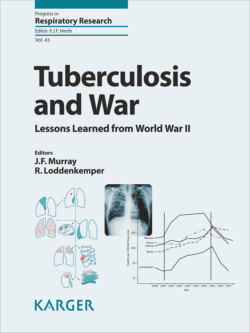Читать книгу Tuberculosis and War - Группа авторов - Страница 16
На сайте Литреса книга снята с продажи.
Early Observations
ОглавлениеTB has traditionally been considered a disease of “antiquity.” And as far back as 460 BCE, the Hippocratic Corpus included reference to TB, or whatever symptom-complex was referenced at the time; moreover, the Corpus warned physicians to avoid caring for such patients when seriously ill, because their high mortality rates were damaging to their professional reputations [17]. For centuries thereafter, arguments raged over whether TB was caused by miasmas, atmospheric imbalances, heredity constitutional defects, contagion, or even divine intervention. In 1720, an English physician, Benjamin Martin, postulated that TB was caused by “wonderfully minute living creatures,” and he believed that getting too close to “consumptives” would “draw in part of the breath he emits from the lungs,” which could transmit the disease [18]. But then nearly another century went by overflowing with supposition and mystery.
In the early 1800s, an important first start leading to an accurate diagnosis of TB was made by René T. H. Laennec, the “Father of Pulmonary Disease” and inventor of the stethoscope. In his studies on the pathologic findings of hundreds of autopsies, Laennec made the “inspired deduction” that the morphologic similarities among the abundant pulmonary abnormalities – including neighboring infiltrations and cavities as well as all the various extrapulmonary lesions – were caused by a single disease, which he called “phthisis” [19]. Not long afterward, Johann Schönlein of Berlin demonstrated that “the tubercle was the fundamental pathologic lesion” in all organs affected by the disease, which he therefore designated as “TB” [19]. Getting even closer to an answer, in 1865 Jean-Antoine Villemin, a French military surgeon, proved by transmitting pathologic material from victims of TB to a variety of experimental animals that TB was a communicable infectious disease [20, 21]. Villemin should have received far more attention to this seminal observation than he had hoped for, but the Franco-Prussian War intervened.
Finally, it was left for Robert Koch (Fig. 1), physician-scientist in Berlin, Germany, to author “one of the most definitive pronouncements in medical history” [22] on March 24, 1882. Like his great rival Louis Pasteur, Koch was already famous for his studies on the pathogenesis and life cycle of anthrax, a common and important disease of domestic and wild animals that occasionally strikes humans. Most accounts affirm that this was Koch’s maiden exposition and he started by fumbling with his notes and was obviously nervous. But after he got going, no one cared
because slowly and methodically he convinced his spellbound audience that a bacterium, which he had invented a novel way of staining so that it could be seen under a microscope, which he had succeeded for the first time ever in growing on artificial culture medium, and which he had then used to infect laboratory animals and reproduce the identical disorder, caused the most important disease of mankind of all time – TB. [22]
Seventeen days after Koch’s brilliant presentation, incredibly fast compared with current publishing norms, a seminal article announcing his discovery appeared in a major medical journal [23]. The news spread quickly. Many physicians were greatly impressed but, as expected, skeptics wanted to be certain. Koch became instantly famous, as illustrated in Figure 1. Kaiser Wilhelm I appointed him Professor and an Imperial Privy Councilor, upped his salary and research support, and added more laboratory assistants [24].
But there remained a nagging uncertainty about TB itself: was it one disease or two? Koch and other specialists knew with certainty that TB occurred in both cattle as well as humans, but no one at the time could be sure whether 2 different species of Mycobacterium were involved. Koch believed – wrongly – “that bovine disease posed no threat to humans” [22]. In 1896, Smith [25] showed “sharp differences” between M. tuberculosis and M. bovis, including their staining characteristics, morphology, and manifestations in infants and children. Five years later (1901), Koch [26] was still trivializing the public importance of M. bovis as an agent of disease; he wrote, “if such a susceptibility really exists,… (it) is but a very rare occurrence.”
Fig. 1. An engraving depicting German Bacteriologist Robert Koch (1843–1910) as the new Saint George after he isolated the bacillus of tuberculosis. Original publication: The Review of Reviews, London. English language version of an original image published in the satirical magazine Ulk in Berlin, 1890. Photo by Hulton Archive/Getty Images, with permission.
Koch waffled about the virulence of M. bovis, but he triumphed once again for his discovery of tuberculin. Although initially he misjudged its value as treatment for TB, the subsequent use of tuberculin by skin testing as an indicator of the presence of either active disease or latent infection of both M. tuberculosis and M. bovis “led to the virtual eradication of TB-ridden cattle and other domesticated animals in industrialized countries” [27].
Fig. 2. Changes in mortality from presumed tuberculosis in the city of London, England, between 1631 and 1901 [54], with permission from Oxford University Press.
Fig. 3. Schematic model of the trend of mortality from tuberculosis in Western Europe from 1740 to 1985. Modified from [18] and using data from [57], with permission from the American Thoracic Society.
Fig. 4. Fragment from the Stele of Vultures. Victory stele of King Eannutum of Lagash over Umma, showing the first extant evidence of an ancient army equipped with helmets, shields and spears. Limestone, circa 2450 BC, Summerian archaic dynasties. Found in 1881 in Girsu (now Tello, Iraq), Mesopotamia, by Edourad de Sarzec. Currently in Louvre Museum, Paris, France. Eric Gaba, July 15, 2005, with permission from Sting.
Fig. 5. Tuberculosis death rates in Great Britain, Belgium, the Netherlands, and Denmark during Fifty Year Period, 1885–1935, with permission from Sheridan Content Solutions, Sheridan, PA, on behalf of The American Public Health Association.
